
newspaper more
Rethinking the Dynamics of Best Online Slots: A Dialectical Analysis
Evelyn Sparks
An Innovative View on Best Online Slots
In an era where digital entertainment redefines risk and reward, the world of online slots stands at a crossroads. Traditionally labelled as a game of chance, the classic slot machines have evolved into a sophisticated digital experience which incorporates true probability models and advanced bank
Examining True Probability and Classic Mechanics
The concept of true probability in online slots is grounded in strict algorithms that offer realistic outcomes, ensuring fairness. Yet, what appears as a mere simulation of the classic slot machine is deeply intertwined with the principles of divided bankroll, where effective risk segmentation can enhance long-term play. Data from the American Gaming Association (2022) emphasizes that strategic bankroll management can mitigate losses and optimize returns, urging players to consider risk volatility when planning their wagers. Furthermore, studies by Gaming Laboratories International (2021) reveal that modern slot algorithms, juxtaposed with traditional mechanics, yield a more controlled gaming environment,
Balancing Divided Bankroll, Risk Volatility, and Reward Redeem
The dialectic between risk and reward in the online slots arena serves as a fertile ground for in-depth analysis. On one hand, the divided bankroll strategy provides a buffer against the inherent risk volatility; on the other, a meticulously calculated risk-return ratio can unlock substantial reward redeem opportunities. The reverse structure of traditional risk models challenges players to continuously reassess their strategies, creating a dynamic environment where each spin is a blend of calculated risk and potential high reward. This complexity reflects the broader debate in financial risk management, where quantitative measures are employed to maximize yield while minimizing downside.In the pursuit of optimizing strategy, one must ask: How much risk is acceptable? Can true probability models be further refined to balance risk more equitably? Does reward redeem offer a sustainable incentive in the long run?
FAQ
FAQ
Q1: What distinguishes classic online slots from modern digital versions?
A1: Classic slots rely on simpler mechanics with lower complexity, whereas modern versions integrate advanced probability algorithms and bankroll management strategies.
Q2: How does divided bankroll strategy impact risk management?
A2: This strategy segments capital to limit losses on any single bet, thus effectively managing risk volatility.
Q3: What role does risk-return ratio play in online slots?
A3: It is fundamental for balancing potential rewards against risks, ensuring that players maintain a sustainable gaming approach.
What strategies do you use to manage risk? Have you experienced shifts in your gaming approach due to enhanced algorithm transparency? Do you believe true probability can fully level the playing field? Your thoughts and experiences are welcome!
Discover Yono Slots' Losing Draw: Every setback instantly becomes a setup for an unforgettable victory.
newspaper news
Strategic Spins and Calculated Ladders: Redefining the Bonus Cash Frontier
newspaper more
Reels of Fortune: Embracing Highroller Spirit with Responsible Play
newspaper news
Grand Strategies in Modern Fiscal Gaming: A Dialectical Analysis
topics
Unleashing the Bold World of PCI Slots: A Contrasting Journey Through Risk and Rewards
newspaper more
Urban Geometry Unlocked: Mastering Reserve Funding & Risk Control
headline more
Innovative Financial Strategies: An In-Depth Analysis of Split Capital Techniques
headline exclusive
Quantum Spin Dynamics: Unveiling the Intricacies of Jackpot Mechanics, Unit Betting, and Bonus Credits
headline more
Spin the Nexus: Mastering True Odds in Gamemania
newspaper more
Adapting the Odds: A Comparative Dialogue on Modern Betting Dynamics
topics
Innovative Trends in High-Stake Gambling: A New Era of Sidebets and Flat Betting


Comments
PlayerOne
This article opened a new perspective on online slots. I never considered the significance of divided bankroll in risk management before.
张伟
非常有见地的分析!它强调了经典玩法与现代策略之间的辩证关系,非常吸引人。
LuckyBeat
The integration of true probability and risk-return ratio really made me rethink my approach to online slots.
花花
真是一次思辨性的文章,让我对游戏背后的数学模型有了更深的认识。